Impact of Mulching on Soil Moisture and Sap Flow Characteristics of Jujube Trees
Abstract
:1. Introduction
2. Materials and Methods
2.1. Experimental Design
2.1.1. Experimental Equipment
2.1.2. Experiment Materials
2.1.3. Experimental Plot Design
2.2. Measurement Indicators and Methods
2.2.1. Soil Moisture
2.2.2. Sap Flow
2.2.3. Sapwood Area
2.2.4. Meteorological Factors
2.2.5. Statistical Analysis
3. Results
3.1. Influence of Grass Planting and Branch Mulching on Soil Moisture Condition in Jujube Orchards
3.1.1. Vertical Distribution of Soil Moisture under Grass Planting and Branch Mulching during the Critical Period of Jujube Tree Water Demand
3.1.2. Vertical Distribution of Soil Moisture under Grass Planting and Branch Mulching during the Soil Water Storage Period
3.1.3. Soil Moisture Retention Effect of Grass Planting and Branch Mulching
3.2. Effects of Grass Planting and Branch Mulching on the Sap Flow Characteristics of Jujube Tree Trunks
3.2.1. Diurnal Variations in Sap Flow of Jujube Tree Trunks
3.2.2. Changes in Daily Average Sap Flow Velocity in Jujube Tree Trunks during the Growing Season
3.2.3. The Relationship between Stem Sap Flow and Environmental Factors
3.2.4. Monthly Variation of Jujube Tree Transpiration Water Consumption
4. Discussion
4.1. Impact of Grass Plantation and Tree Branch Mulching on Soil Moisture Conditions
4.2. Influence of Grass Planting and Tree Branch Mulching on Jujube Tree Transpiration
5. Conclusions
Author Contributions
Funding
Data Availability Statement
Conflicts of Interest
References
- Wan, S.; Yang, Z.; Huang, Y.; Wang, L.; Sun, J.; Liu, F.; Zhang, H.; Wang, L.; Wang, S.; Zhao, W.; et al. Analysis and comprehensive evaluation of fruit quality of Huizao in different regions of Southern Xinjiang. Non-Wood For. Res. 2022, 40, 143–152. [Google Scholar]
- Wei, X.; Li, B.; Guo, C.; Wang, Y.; He, J.; Liu, S.; Wang, T.; Yao, M. Identification of sap flow driving factors of jujube plantation in semi-arid areas in Northwest China. Int. J. Agric. Biol. Eng. 2017, 10, 172–183. [Google Scholar]
- Liu, M.; Liu, P. Artificial autopolyploidization in jujube. Sci. Hortic. 2023, 314, 111916. [Google Scholar] [CrossRef]
- Shi, Q.; Li, X.; Du, J.; Liu, Y.; Shen, B.; Li, X. Association of Bitter Metabolites and Flavonoid Synthesis Pathway in Jujube Fruit. Front. Nutr. 2022, 9, 901756. [Google Scholar] [CrossRef]
- Zhu, B.; Wen, X.; Wei, G. Effect of pre-treatments on drying characteristics of Chinese jujube (Zizyphus jujuba Miller). Int. J. Agric. Biol. Eng. 2014, 7, 94–102. [Google Scholar]
- Fan, D.; Jin, J.; Abudoukayoumu, A.; Yang, L.; Zhao, X.; Hao, Q. Comprehensive Evaluation of Fruit Quality Characteristics of 5 Fresh Jujube Varieties. Xinjiang Agric. Sci. 2022, 59, 1956–1964. [Google Scholar]
- Rouzi, A.; Halik, Ü.; Thevs, N.; Welp, M.; Aishan, T. Water efficient alternative crops for sustainable agriculture along the Tarim basin: A comparison of the economic potentials of Apocynum pictum, Chinese red date and cotton in Xinjiang, China. Sustainability 2017, 10, 35. [Google Scholar] [CrossRef]
- Ai, N.; Zong, Q.; Gao, J.; Qiang, D.; Liu, C. Dynamics Change of Soil Moisture in Mountain Jujube Forest after Rainy Season in Loess Area of Northern Shaanxi Province. Bull. Bot. Res. 2020, 40, 559–567. [Google Scholar]
- Li, L.; Zhao, L.; Ge, J.; Li, H.; Yang, P. Age-and Drought-Related Variation in Plant-Available Water of Rain-Fed Jujube Orchards on the Loess Plateau of China. Sustainability 2022, 14, 10998. [Google Scholar] [CrossRef]
- Yan, X.; Zhang, Q.; Zhang, P.; Liu, Q.; Hao, Z.; Li, G.; Liu, Y. Risk analysis and management of jujube witches’ broom disease in Shaanxi Province, China. J. Biosaf. 2022, 31, 262–267. [Google Scholar]
- Yan, X.; Cheng, X.; Hao, Z.; Wang, T.; Qin, F.; Li, G. Spatial distribution patterns and sampling techniques of Dasineura jujubifolia larvae on facility jujube trees. J. Nanjing For. Univ. Nat. Sci. Ed. 2022, 46, 201–208. [Google Scholar]
- Li, B.; Muhammad, N.; Zhang, S.; Lan, Y.; Yang, Y.; Han, S.; Liu, M.; Yang, M. Multiple-Genome-Based Simple Sequence Repeat Is an Efficient and Successful Method in Genotyping and Classifying Different Jujube Germplasm Resources. Plants 2023, 12, 2885. [Google Scholar] [CrossRef] [PubMed]
- Ling, Q.; Gao, X.; Zhao, X.; Huang, J.; Li, H.; Li, L.; Sun, W.; Wu, P. Soil water effects of agroforestry in rainfed jujube (Ziziphus jujube Mill.) orchards on loess hillslopes in Northwest China. Agric. Ecosyst. Environ. 2017, 247, 343–351. [Google Scholar] [CrossRef]
- Chen, D.; Wang, Y.; Zhang, X.; Wei, X.; Duan, X.; Muhammad, S. Understory mowing controls soil drying in a rainfed jujube agroforestry system in the Loess Plateau. Agric. Water Manag. 2021, 246, 106703. [Google Scholar] [CrossRef]
- Huo, G.; Zhao, X.; Gao, X.; Wang, S.; Pan, Y. Soil Water Use and Competition in Jujube-crop Systems in Loess Hilly Region. J. Nat. Resour. 2017, 32, 2043–2054. [Google Scholar]
- Farzi, R.; Gholami, M.; Baninasab, B.; Gheysari, M. Evaluation of different mulch materials for reducing soil surface evaporation in semi-arid region. Soil Use Manag. 2017, 33, 120–128. [Google Scholar] [CrossRef]
- Locher, J.; Ombódi, A.; Kassai, T.; Dimeny, J. Influence of coloured mulches on soil temperature and yield of sweet pepper. Eur. J. Hortic. Sci. 2005, 70, 135–141. [Google Scholar]
- Paliaga, S.; Lucia, C.; Pampinella, D.; Muscarella, S.M.; Badalucco, L.; Palazzolo, E.; Laudicina, V.A. Shifting Long-Term Tillage to Geotextile Mulching for Weed Control Improves Soil Quality and Yield of Orange Orchards. Agriculture 2023, 13, 764. [Google Scholar] [CrossRef]
- Fernández, C.; Vega, J.A. Efficacy of bark strands and straw mulching after wildfire in NW Spain: Effects on erosion control and vegetation recovery. Ecol. Eng. 2014, 63, 50–57. [Google Scholar] [CrossRef]
- Noor, M.A.; Nawaz, M.M.; Ma, W.; Zhao, M. Wheat straw mulch improves summer maize productivity and soil properties. Ital. J. Agron. 2021, 16, 1623. [Google Scholar] [CrossRef]
- Wang, Y.; Li, X.; Hai, L.; Siddique, K.H.; Gan, Y.; Li, F. Film fully-mulched ridge-furrow cropping affects soil biochemical properties and maize nutrient uptake in a rainfed semi-arid environment. Soil Sci. Plant Nutr. 2014, 60, 486–498. [Google Scholar] [CrossRef]
- Walsh, B.D.; MacKenzie, A.F.; Salmins, S.; Buszard, D.J. Impact of soil management systems on organic dwarf apple orchards and soil aggregate stability, bulk density, temperature and water content. Can. J. Soil Sci. 1996, 76, 203–209. [Google Scholar] [CrossRef]
- Wang, Y.; Yang, H.; Zhang, W.; Li, X.; Fu, P.; Chen, X.; Zhu, Q.; Jin, B.; Meng, X. Buffer Effect of Grass Planting on Soil Temperature in Apple Orchard on the Loess Plateau. Chin. J. Grassland. 2023, 45, 117–125. [Google Scholar]
- Li, Y.; Hu, Y.; Song, D.; Liang, S.; Qin, X.; Siddique, K.H. The effects of straw incorporation with plastic film mulch on soil properties and bacterial community structure on the loess plateau. Eur. J. Soil Sci. 2021, 72, 979–994. [Google Scholar] [CrossRef]
- Mendonça, S.R.; Ávila, M.C.R.; Vital, R.G.; Evangelista, Z.R.; de Carvalho Pontes, N.; dos Reis Nascimento, A. The effect of different mulching on tomato development and yield. Sci. Hortic. 2021, 275, 109657. [Google Scholar] [CrossRef]
- Long, B.; Li, F.; Wang, K.; Huang, Y.; Yang, Y.; Xie, D. Impact of plastic film mulching on microplastic in farmland soils in Guangdong province, China. Heliyon 2023, 9, e16587. [Google Scholar] [CrossRef]
- Hao, Z.; Sha, Y.; Mi, G. Current Application Status of Maize Residue Mulching in Northeast China and the Policy Recommendation. J. Maize Sci. 2021, 29, 100–110. [Google Scholar]
- Wang, P.; Wang, Y.; Wu, Q. Effects of soil tillage and planting grass on arbuscular mycorrhizal fungal propagules and soil properties in citrus orchards in southeast China. Soil Tillage Res. 2016, 155, 54–61. [Google Scholar] [CrossRef]
- Zhang, P.; Wang, X.; Tao, S.; Bao, J. Effects of Grass Cultivation Years in Orchard on Fruit Morphological Characteristics and Quality of Korla Fragrant Pear. North. Hortic. 2021, 22, 22–28. [Google Scholar]
- Sun, X.; Zhang, C.; Pan, J.; Xu, C.; Hou, Y.; Qin, W.; Xue, J. The effects of coverage on ecological environment, yield and quality of longan orchards. Soil Fertil. Sci. China 2013, 4, 54–58. [Google Scholar]
- Tang, W.; Yang, H.; Wang, W.; Wang, C.; Pang, Y.; Chen, D.; Hu, X. Effects of living grass mulch on soil properties and assessment of soil quality in Chinese apple orchards: A meta-analysis. Agronomy 2022, 12, 1974. [Google Scholar] [CrossRef]
- Wei, C.; Qiao, J.; Ma, Z.; Ma, H.; Tang, X.; Zhao, W.; Yan, Q.; Tang, L.; Du, L. Stylo grass affecting soil respiration in latosol guava orchard of southern subtropical region of China. Agron. J. 2021, 113, 721–733. [Google Scholar] [CrossRef]
- Wei, H.; Zhang, K.; Zhang, J.; Li, D.; Zhang, Y.; Xiang, H. Grass cultivation alters soil organic carbon fractions in a subtropical orchard of southern China. Soil Tillage Res. 2018, 181, 110–116. [Google Scholar] [CrossRef]
- Liu, C.; Du, T.; Li, F.; Kang, S.; Li, S.; Tong, L. Trunk sap flow characteristics during two growth stages of apple tree and its relationships with affecting factors in an arid region of northwest China. Agric. Water. Manag. 2012, 104, 193–202. [Google Scholar] [CrossRef]
- Yamane, T.; Hamana, Y.; Nakano, M. Detection of water-deficit stress from daily sap flow profiles in peach. J. Jpn. Soc. Hortic. Sci. 2011, 80, 383–389. [Google Scholar] [CrossRef]
- Keyimu, M.; Halik, Ü.; Rouzi, A. Relating water use to tree vitality of Populus euphratica Oliv. in the lower Tarim River, NW China. Water 2017, 9, 622. [Google Scholar] [CrossRef]
- Gao, X.; Wu, P.; Zhao, X.; Shi, Y.; Wang, J.; Zhang, B. Soil moisture variability along transects over a well-developed gully in the Loess Plateau, China. Catena 2011, 87, 357–367. [Google Scholar] [CrossRef]
- Wu, D.; Yu, Y.; Xia, L.; Yin, S.; Yang, L. Soil fertility indices of citrus orchard land along topographic gradients in the three gorges area of China. Pedosphere 2011, 21, 782–792. [Google Scholar] [CrossRef]
- Huang, D.; Wang, L.; Li, W.; Qiu, X.; Luo, T.; Weng, B. Effects of inter-planting forage with tea on yield and soil fertility. Chin. J. Eco-Agric. 2014, 22, 1289–1293. [Google Scholar]
- He, Z.; Fu, Y. Research on the Water Consumption Law and Yield of Jujube Trees under the Condition of Bubbled-root Irrigation. China Rural Water Hydropower 2018, 9, 85–89. [Google Scholar]
- Granier, A. A new method of sap flow measurement in tree stems. Ann. For. Sci. 1985, 42, 193–200. [Google Scholar] [CrossRef]
- Zhou, C.; Gu, D.; Zhao, P.; Huang, K.; He, W.; Yao, Y.; Zhu, L.; Huang, Y. Effect of sap flow radial variation on daily transpiration estimation of Eucalyptus urophylla × Eucalyptus grandis. Chin. J. Appl. Ecol. 2017, 28, 2445–2451. [Google Scholar]
- Kannan, P.; Ponmani, S.; Prabukumar, G.; Swaminathan, C. Effects of crop residue mulch and seedbed preparation methods on soil properties and rainfed groundnut production in alfisols of semi-arid India. Soil Use Manag. 2020, 37, 479–493. [Google Scholar]
- Qin, S.; Li, S.; Yang, K.; Hu, K. Can plastic mulch save water at night in irrigated croplands? J. Hydrol. 2018, 564, 667–681. [Google Scholar] [CrossRef]
- Fan, D.; Jia, G.; Wang, Y.; Yu, X. The effectiveness of mulching practices on water erosion control: A global meta-analysis. Geoderma 2023, 438, 116643. [Google Scholar] [CrossRef]
- Ma, J.; Wang, X.; Zhao, X.; Tian, L.; Wang, Y. Experimental study of mulching effects on water restoration of deep, desiccated soil in a loess hilly region. Environ. Technol. 2022, 43, 3462–3472. [Google Scholar] [CrossRef] [PubMed]
- Zhao, L.; Zhang, L.; Zhao, N.; Ge, J.; Jin, J. Water Use Strategy of Fruit-Grass Complex Systems in Different Habitats Based on Isotope Tracer. J. Soil Water Conserv. 2022, 36, 86–94. [Google Scholar]
- Bai, G.; Zheng, S.; Zou, C.; Du, S. Influence of Interplant Herbage on Soil Moisture and Apple Tree Growth in Dry Plateau of Eastern Gansu. Acta Agrestia Sin. 2018, 26, 173–183. [Google Scholar]
- Li, H. Eco-Environmental Effect and Integrated Technical System of Green Cover in Apple Orchard in Weibei Dryland Farming Areas. Ph.D. Thesis, Northwest Agriculture & Forestry University, Yangling, China, 2008. [Google Scholar]
- Hong, G.; Wang, X.; Gao, X.; Hu, E.; Li, Z.; Li, Z.; Liu, T.; Yang, H.; Xi, W.; Wang, L. Responses of sap flow of Hedysarum leave to climatic factors in Mu Us Sandy land. Acta Ecol. Sin. 2023, 43, 1635–1645. [Google Scholar]
- Liu, X.; Li, X.; Hai, L.; Wang, Y.; Li, F. How efficient is film fully-mulched ridge–furrow cropping to conserve rainfall in soil at a rainfed site? Field Crops Res. 2014, 169, 107–115. [Google Scholar] [CrossRef]
- Li, H. Study on the Mechanism of Evapotranspiration on Jujube under Covering in Fish-Scale Pits at the Loess Hilly Region. Ph.D. Thesis, Northwest Agriculture & Forestry University, Yangling, China, 2018. [Google Scholar]
- Xing, L. Effect of Planting Grass in Apple Orchard on Photosynthetic Transpiration and Water Use Efficiency of Fruit Trees. For. Sci. Technol. 2019, 9, 74–75. [Google Scholar]
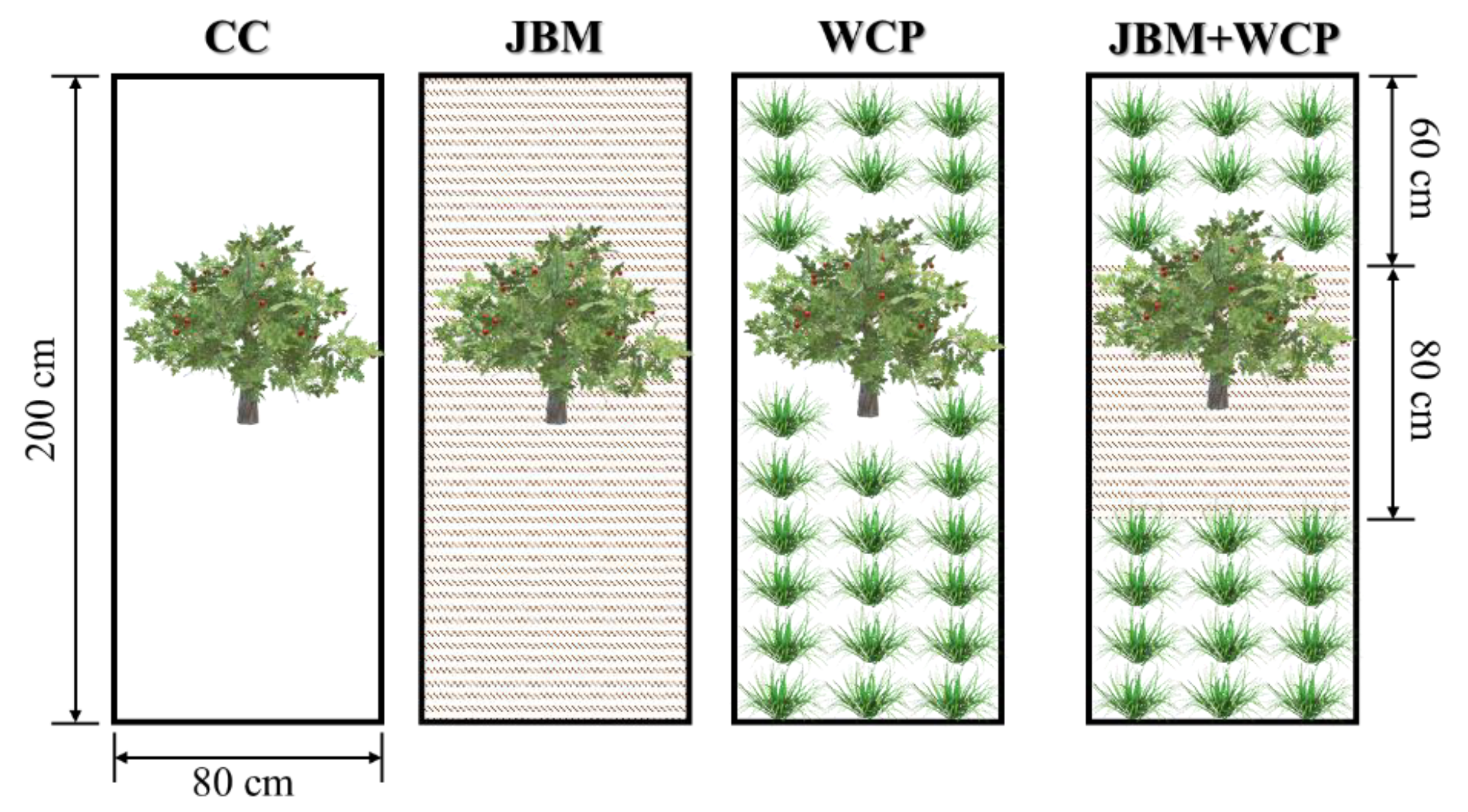

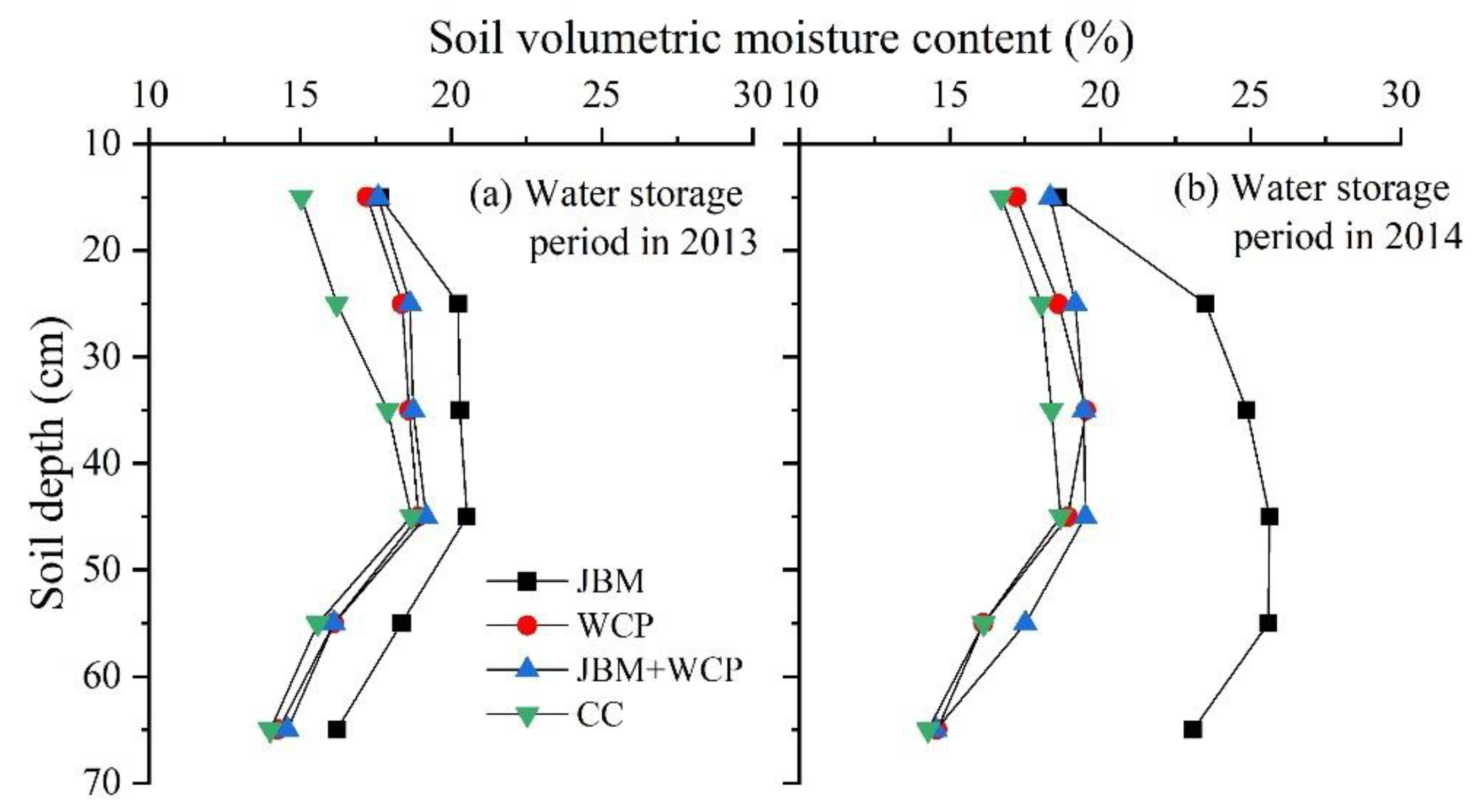
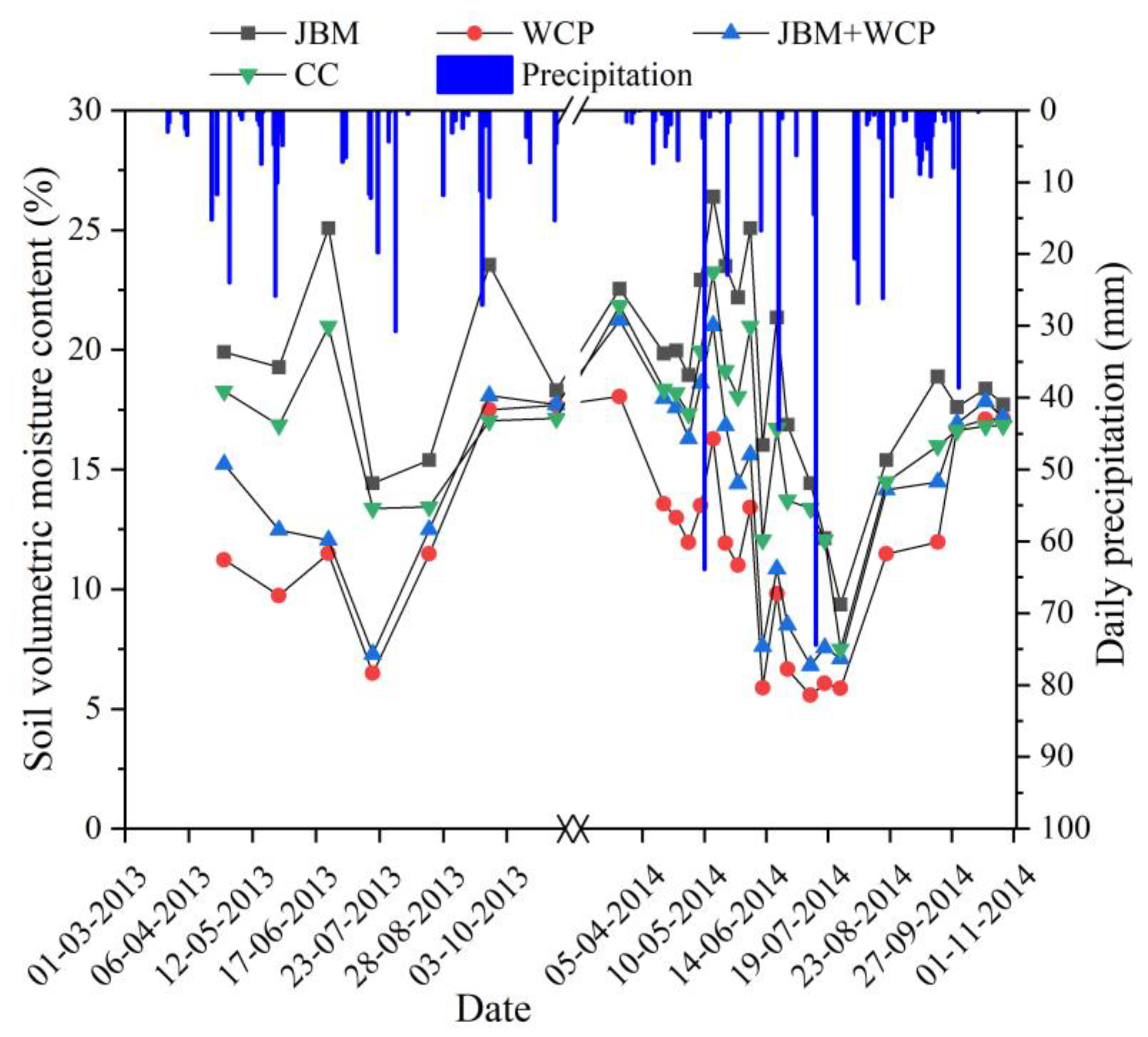


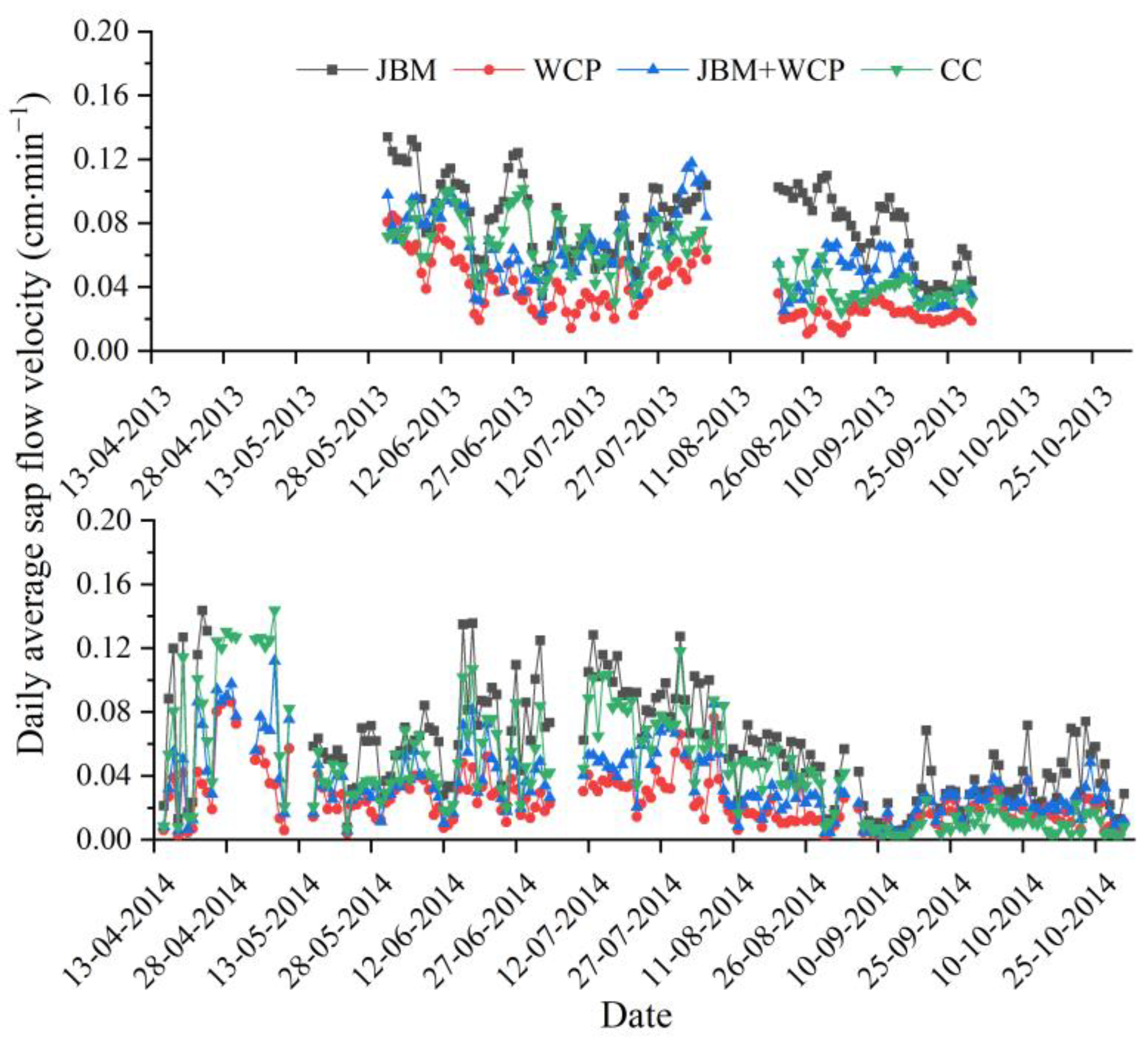
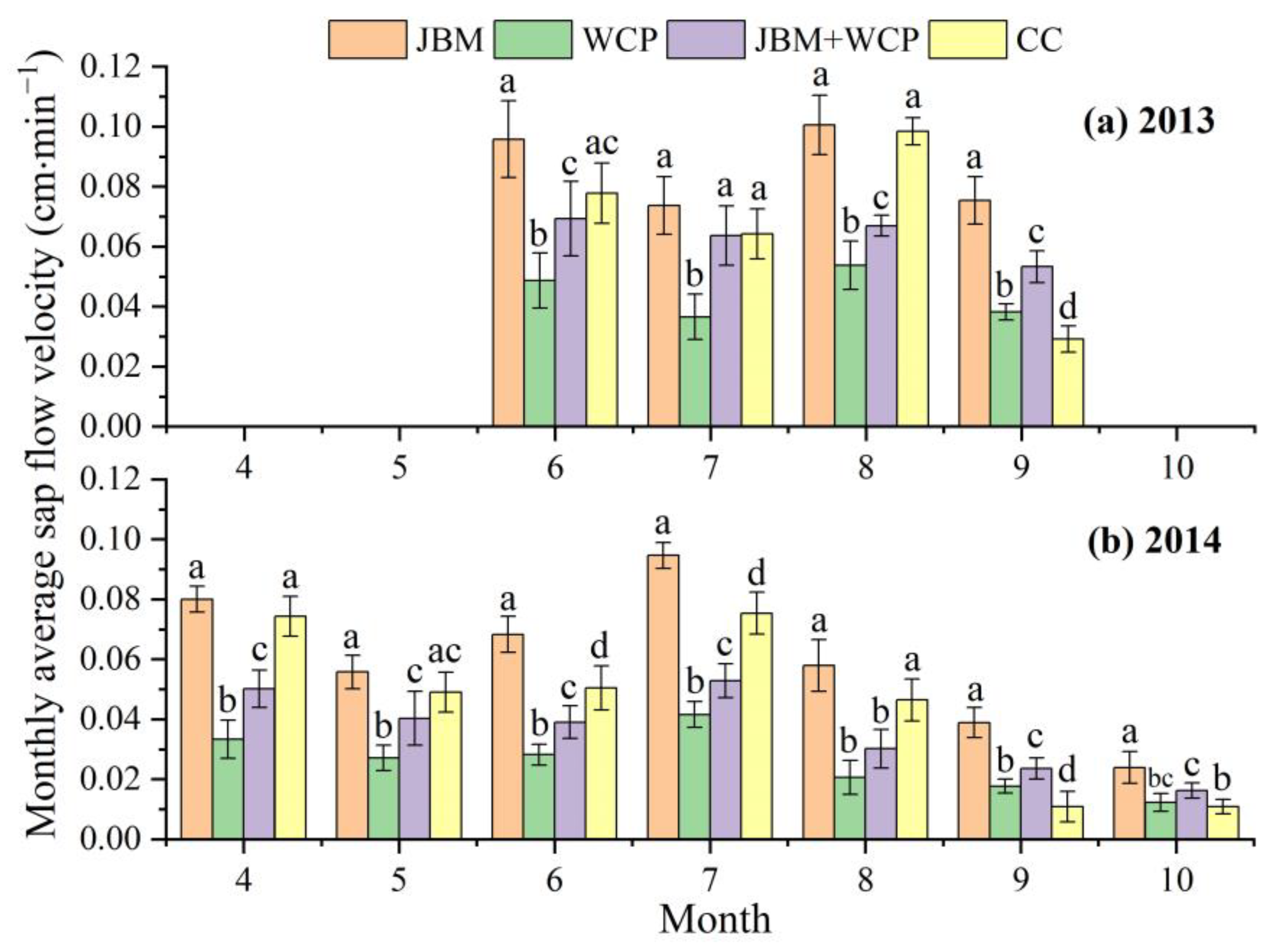

| Particle Size (mm) | Content (%) | Saturated Hydraulic Conductivity (mm·min−1) | Saturated Moisture Content (%) | Field Capacity (%) | Wilting Coefficient (%) |
|---|---|---|---|---|---|
| <0.002 | 18.1 ± 2.6 | 0.49 ± 0.15 | 53.7 ± 1.9 | 29.4 ± 0.96 | 8.44 ± 1.32 |
| 0.002–0.02 | 64.3 ± 1.8 | ||||
| 0.02–2 | 17.6 ± 1.3 |
| Year | Weather | Treatment | Starting Time | Peak Time | Peak Value (cm·min−1) | Daily Average Sap Flow Velocity (cm·min−1) | Time of Rapid Decline | End Time |
|---|---|---|---|---|---|---|---|---|
| 2013 | Sunny day | JBM | 6:20 | 9:10 | 0.2835a | 0.1054a | 17:50 | 20:30 |
| WCP | 7:00 | 9:30 | 0.1102b | 0.0524b | 17:50 | 19:30 | ||
| JBM + WCP | 7:00 | 9:30 | 0.1937c | 0.0785a | 17:50 | 20:20 | ||
| CC | 6:40 | 9:20 | 0.1940c | 0.0902a | 17:50 | 20:30 | ||
| Cloudy day | JBM | 6:40 | 9:50 | 0.2335a | 0.0544a | 14:50 | 20:00 | |
| WCP | 7:10 | 9:50 | 0.0858b | 0.0196b | 14:50 | 19:10 | ||
| JBM + WCP | 7:00 | 9:50 | 0.1472c | 0.0427a | 14:50 | 19:20 | ||
| CC | 6:20 | 9:50 | 0.1787d | 0.0524a | 14:50 | 20:30 | ||
| 2014 | Sunny day | JBM | 6:30 | 9:30 | 0.1773a | 0.0910a | 18:10 | 20:50 |
| WCP | 6:40 | 9:20 | 0.0727b | 0.0363b | 18:10 | 20:50 | ||
| JBM + WCP | 6:40 | 9:10 | 0.1612c | 0.0676a | 18:20 | 20:50 | ||
| CC | 6:40 | 9:30 | 0.1636c | 0.0781a | 18:10 | 21:00 | ||
| Cloudy day | JBM | 7:20 | 12:00 | 0.1630a | 0.0569a | 14:30 | 20:20 | |
| WCP | 7:20 | 12:00 | 0.0657b | 0.0317b | 14:30 | 20:20 | ||
| JBM + WCP | 7:10 | 12:00 | 0.1409c | 0.0375b | 14:30 | 20:30 | ||
| CC | 7:30 | 12:00 | 0.1530d | 0.0379b | 14:30 | 20:30 |
| Year | Treatment | Sunny Days | Cloudy Days | ||||
|---|---|---|---|---|---|---|---|
| WCP | JBM + WCP | CC | WCP | JBM + WCP | CC | ||
| 2013 | JBM | 0.001 ** | 0.096 | 0.348 | 0.000 ** | 0.172 | 0.817 |
| WCP | 0.104 | 0.019 * | 0.007 ** | 0.000 ** | |||
| JBM + WCP | 0.465 | 0.256 | |||||
| 2014 | JBM | 0.000 ** | 0.076 | 0.324 | 0.003 ** | 0.020 * | 0.023 * |
| WCP | 0.018* | 0.002 ** | 0.478 | 0.447 | |||
| JBM + WCP | 0.428 | 0.959 | |||||
| Year | Growth Stage | Treatment | Tair | VPD | Vwind | PAR | Tsoil |
|---|---|---|---|---|---|---|---|
| 2013 | June to September | JBM | 0.512 * | 0.672 ** | 0.439 * | 0.872 ** | −0.2 |
| WCP | 0.38 | 0.480 ** | 0.339 | 0.862 ** | 0.017 | ||
| JBM + WCP | 0.415 | 0.316 ** | 0.39 | 0.779 ** | 0.108 | ||
| CC | 0.643 ** | 0.744 ** | 0.658 ** | 0.911 ** | 0.001 | ||
| 2014 | Sprouting and leaf spreading period | JBM | 0.386 | 0.678 * | −0.267 | 0.808 ** | 0.446 |
| WCP | 0.116 | 0.381 | −0.16 | 0.801 ** | 0.066 | ||
| JBM + WCP | 0.391 | 0.627 ** | −0.097 | 0.909 ** | 0.355 | ||
| CC | 0.473 * | 0.707 ** | −0.135 | 0.941 ** | 0.445 * | ||
| Flowering and fruiting period | JBM | 0.650 ** | 0.702 ** | −0.005 | 0.690 ** | 0.671 ** | |
| WCP | 0.261 * | 0.409 ** | 0.207 | 0.671 ** | 0.18 | ||
| JBM + WCP | 0.362 ** | 0.479 ** | 0.115 | 0.689 ** | 0.319 * | ||
| CC | 0.580 ** | 0.676 ** | 0.122 | 0.696 ** | 0.581 ** | ||
| Fruit expansion period | JBM | 0.828 ** | 0.816 ** | 0.705 ** | 0.697 ** | 0.848 ** | |
| WCP | 0.478 * | 0.483 ** | 0.426 ** | 0.393 ** | 0.598 ** | ||
| JBM + WCP | 0.618 ** | 0.656 ** | 0.599 ** | 0.485 ** | 0.738 ** | ||
| CC | 0.701 ** | 0.680 ** | 0.644 ** | 0.571 ** | 0.769 ** | ||
| Fruit ripening period | JBM | −0.002 | 0.483 * | 0.221 | 0.035 | −0.044 | |
| WCP | 0.069 | 0.327 | 0.029 | 0.399 * | 0.072 | ||
| JBM + WCP | 0.245 | 0.337 | 0.009 | 0.426 * | 0.244 | ||
| CC | 0.227 | 0.155 | −0.04 | 0.443 * | 0.304 |
| Year | Growth Stage | Treatment | Regression Equation | R2 | Sig. |
|---|---|---|---|---|---|
| 2013 | June to September | JBM | Fd = 3.597 × 10−2 + 2.418×10−2VPD + 1.267 × 10−3PAR | 0.525 | 0.000 |
| WCP | Fd = 8.885 × 10−3 + 1.595 × 10−3PAR | 0.603 | 0.000 | ||
| JBM + WCP | Fd = 3.016 × 10−2 + 1.746 × 10−3PAR | 0.529 | 0.000 | ||
| CC | Fd = 1.766 × 10−2 + 2.453 × 10−2VPD + 8.970 × 10−4PAR | 0.607 | 0.000 | ||
| 2014 | Sprouting and leaf spreading period | JBM | Fd = −3.886 × 10−1 + 2.861 × 10−4PAR + 2.792 × 10−2Tsoil | 0.810 | 0.003 |
| WCP | Fd = 7.632 × 10−2 + 1.463 × 10−4PAR−4.972 × 10−3Tsoil | 0.730 | 0.000 | ||
| JBM + WCP | Fd = 7.686 × 10−3 + 1.652 × 10−4PAR | 0.827 | 0.000 | ||
| CC | Fd = 1.065 × 10−2 + 2.503 × 10−4PAR | 0.885 | 0.000 | ||
| Flowering and fruiting period | JBM | Fd = −7.130 × 10−2 + 1.023 × 10−4PAR + 4.001 × 10−3Tsoil | 0.668 | 0.000 | |
| WCP | Fd = 7.312 × 10−3 + 5.051 × 10−5PAR | 0.671 | 0.000 | ||
| JBM + WCP | Fd = 8.890 × 10−3 + 7.247 × 10−5PAR | 0.689 | 0.000 | ||
| CC | Fd = −5.683 × 10−2 + 9.830 × 10−5PAR + 2.782 × 10−3Tsoil | 0.630 | 0.000 | ||
| Fruit expansion period | JBM | Fd = −7.610 × 10−2 + 5.206 × 10−5PAR + 4.306 × 10−3Tsoil | 0.780 | 0.000 | |
| WCP | Fd = −2.097 × 10−2 + 3.046×10−5PAR + 5.784 × 10−3Tsoil−5.080 × 10−3Tair | 0.496 | 0.000 | ||
| JBM + WCP | Fd = −4.308 × 10−2 + 3.887 × 10−5PAR + 7.749 × 10−3Tsoil−5.994 × 10−3Tair | 0.663 | 0.000 | ||
| CC | Fd = 7.483 × 10−2 + 4.450 × 10−3Tsoil | 0.592 | 0.000 | ||
| Fruit ripening period | JBM | Fd = 2.211 × 10−2 + 9.066 × 10−2VPD−7.274 × 10−3Vwind−6.386 × 10−5PAR | 0.642 | 0.000 | |
| WCP | Fd = 1.391 × 10−2 + 2.532 × 10−5PAR | 0.399 | 0.039 | ||
| JBM + WCP | Fd = 1.335 × 10−2 + 4.076 × 10−2VPD−3.279 × 10−3Vwind | 0.572 | 0.000 | ||
| CC | Fd = 6.887 × 10−3 + 2.204 × 10−5PAR | 0.443 | 0.027 |
Disclaimer/Publisher’s Note: The statements, opinions and data contained in all publications are solely those of the individual author(s) and contributor(s) and not of MDPI and/or the editor(s). MDPI and/or the editor(s) disclaim responsibility for any injury to people or property resulting from any ideas, methods, instructions or products referred to in the content. |
© 2023 by the authors. Licensee MDPI, Basel, Switzerland. This article is an open access article distributed under the terms and conditions of the Creative Commons Attribution (CC BY) license (https://creativecommons.org/licenses/by/4.0/).
Share and Cite
He, Y.; Qiu, Z.; Liu, R.; Tang, M.; Wu, P. Impact of Mulching on Soil Moisture and Sap Flow Characteristics of Jujube Trees. Agronomy 2023, 13, 2799. https://doi.org/10.3390/agronomy13112799
He Y, Qiu Z, Liu R, Tang M, Wu P. Impact of Mulching on Soil Moisture and Sap Flow Characteristics of Jujube Trees. Agronomy. 2023; 13(11):2799. https://doi.org/10.3390/agronomy13112799
Chicago/Turabian StyleHe, Yi, Zhikai Qiu, Rui Liu, Min Tang, and Pute Wu. 2023. "Impact of Mulching on Soil Moisture and Sap Flow Characteristics of Jujube Trees" Agronomy 13, no. 11: 2799. https://doi.org/10.3390/agronomy13112799





